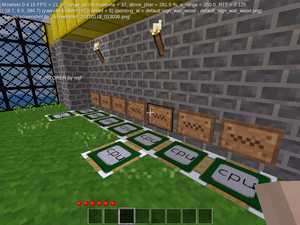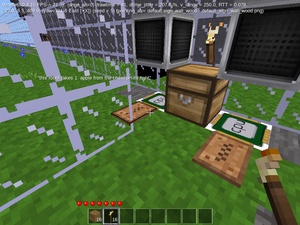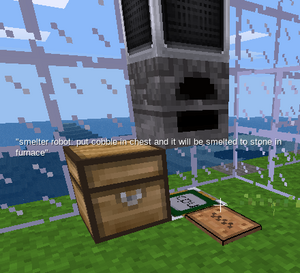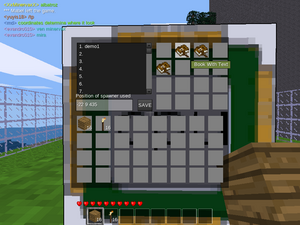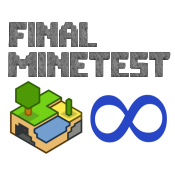Mods/basic robot/tutorial: Difference between revisions
>Ghoti (→Explorer1: follow the right wall) |
>Ghoti (→Explorer1: follow the right wall) |
(No difference)
| |
Revision as of 23:59, 23 April 2021
Tutorial 1
There is a 'live' tutorial-parcour about programming rnd's basic_robots
at his ROBOTS-server, 46.150.38.198:30000.
It can be reached via teleporter near the spawn.
How to reach the tutorial
- At login, solve the math-quiz to get teleported out of the spawn-building
- it might take up to 10 seconds for the dialog to pop up
- look for the teleporter - it has 2 big oranges on top, and a big black button at the floor
- stand on that button, and punch it
Layout of the tutorial-area
- big test-area
- tutorials (0..9, plus some more)
- Wall
- automatic door to next area
- robots with example-programs, and signs at base of wall
- "Lobby" with teleporter
Operation Basics
Short summary about the operation of basic_robots:
- There is a spawner ("cpu"), that has to be put on the ground somewhere.
- This means that players cannot activate their own robots in areas protected by other players.
- The spawner acts as a kind of basestation.
- Robots can only move a certain distance from it.
- Rightclick the spawner to access a form with the code, the inventory and the library
- the inventory has 4*8 slots, same size as a chest, or the player's inventory.
- the library has 16 slots, same as a bookshelf
- When pressing the "start"-button, the spawner creates a robot ("worker") on the space above it
- Each spawner can only control one robot at a time.
- With no code, the robot can be steered with a remote-control
- otherwise, the robot executes the code from the form
- The "Stop"-button stops the program execution, and the robot disappears.
- The code is running in a sandbox, and is called once every second.
In the following chapters,, we present some of those programs, that have been written by rnd and users at his server.
Service Programs
'Service' means, programs that run in place on the robot/spawner, and (maybe) provide some service.
In this tutorial-parcour at the robots-server,
the robots are started with a button-push
on the big black keypads over the spawner.
- The keypad is set to send a 2=ON to the spawner for starting the program.
The keypads are part of the mod basic_machines.
Hello World
To tell the robot what to do, write commands into his code-area.
Rightclick the robot-spawner to see the code.
-- This simple program makes the robot 'talk', as in 'write text to the chat'.
say("Hello! I'm a robot.")
say("A random number: " .. math.random() )
self.remove() -- stop
These commands would be repeated every second,
but "self.remove()" removes the robot, and thus ends the program.
- (Not much 'service' in this program, but it runs 'in place' :)
Chest-Access
With "insert" and "take", robots can put stuff into chests and other containers,
as well as take items out.
This example has a chest, one robot on the left, another on the right,
and one keypad for each robot.
The first robot places 2 apples into the chest on its left:
insert.left("default:apple 2")
--say("Done: insert")
self.remove()
The other robot takes 1 apple from the chest on its right:
take.right("default:apple")
--say("Done: take")
self.remove()
Note: there are no checks for errors, e.g.
- if there are enough apples in the inventory,
- if there is a chest with enough room next to the robot,
- if the chest can be accessed (it might belong to some other player),
- if the action failed for some other reason,
etc.
Catching all those possible errors (and dealing with them) can make 'simple programs' quite complicated.
Math quiz1
The robot generates a math-question (like "WHAT IS 13*19 ?"), and listens to the chat.
Players answer via chat, and the robot will announce "Correct" or "Wrong".
-- MATH QUIZ by rnd
-- QUIZ: asks math question
if not state then
state=1;
a=0; b=0; question = "";
function generate_question()
a = math.random(12)+3;
b = math.random(12)+3;
question = "WHAT IS " .. a .."*".. b .. " ? ";
say(question)
end
generate_question()
end
self.listen(1)
speaker, msg = self.listen_msg()
msg = tonumber(msg)
if msg then
if msg == a*b then
say(speaker .. " ANSWERED CORRECTLY! ")
generate_question()
else
say("WRONG! " .. question)
end
end
turn.left()
Note: it doesn't keep track of who answered, doesn't keep score, and there is only one form of quiz (i.e. a*b).
Math quiz2
The robot generates a math-question (like "WHAT IS 13*19 ?"), and listens to the chat.
Players answer via chat, and if the correct answer comes up,
the robot fills a chest on top of the robot with some items as a reward for that player.
-- math quiz robot: answer correct and take reward from chest
-- QUIZ: asks math question
if not state then
state = 1;
a=0;b=0; question = "";
function generate_question()
a = math.random(12)+10;
b = math.random(12)+10;
question = "WHAT IS " .. a .."*".. b .. " ? ";
say(question)
end
generate_question()
self.listen(1)
end
speaker, msg = self.listen_msg()
msg = tonumber(msg)
if msg then
if msg == a*b then
say(speaker .. " ANSWERED CORRECTLY! You get reward in chest")
insert.up("default:apple")
insert.up("default:pine_tree")
generate_question()
else
say("WRONG! " .. question)
end
end
turn.left()
(Note: there is no check which player takes the price from the chest :)
Also, there is no check if the robot still has items in his inventory to give as reward.
Smelter Robot
This robot moves ore to be smelted from the chest at the left
into the furnace at its top.
The lumps of coal come from the robot's inventory.
--smelter robot: put cobble in chest and it will be smelted to stone in the furnace
insert.up("default:coal_lump","fuel")
if take.left("default:cobble") then
insert.up("default:cobble","src")
end
The keypad to start the robot with a button-push comes from the mod basic_machines.
The furnace starts operating as soon as it has both fuel and ore.
Mobile Programs
'Mobile' means, programs for robots that move around, dig, build, etc.
Simple movement1
This robot will move forward, until blocked, e.g. by a wall, cliff, or some other obstacle.
move.forward()
This command will be repeated every second.
Simple movement2
You can make robots move in all directions and turn around.
The robot can't fly, but it can move up one block above the ground.
move.forward()
move.up()
Climbing upstairs.
Simple movement3
Now, we also check for success of the movement.
-- Using the "if" sentence you can check when robot can't walk anymore
self.spam(1)
if move.forward() then
say("walking ..")
else
say("I hit obstacle. removing robot"); self.remove()
end
The command "move.forward()" is actually a function,
that returns true or false as a result,
meaning the move was successful or not.
So, the if-statement checks if moving forward failed, and if that happens, ends the program.
Explorer1
Moving forward as above, but when moving fails, the robot will turn 90° to the left.
-- A very simple robot: it will turn left when it can't go forward anymore.
if not move.forward() then
turn.left()
end
So, the if-statement checks if moving forward failed, and turns left instead.
Explorer1.1
Simple moves as above, but detects air on the right, to trigger a new turn.
-- Follow the right wall
if read_node.right()=="air" then
turn.right()
end
if not move.forward() then
turn.left()
end
This is essentially a maze-runner, with the strategy "follow the right wall".
Explorer2
--EXPLORER by rnd
if not move.forward() then
say ("i see " .. read_node.forward())
if math.random(2)==1 then
turn.left()
else
turn.right()
end
end
Moves forward until it hits an obstacle (and reports it),
then randomly turns left or right.
Explorer3
-- ADVANCED EXPLORER, can climb stairs
node = read_node.down()
if node == "air" then
move.down()
else -- walk around
if read_node.forward()~="air" then
move.up()
end
if not move.forward() then
if math.random(2)==1 then
turn.left()
else
turn.right()
end
end
end
...
Road-Tracker
There is a cobble-road at the tutorial-parcour,
with turns, crossings, deadends etc.
and his program moves along this road.
-- FOLLOW COBBLE ROAD by rnd
--tracks road
--run then tracker.step()
if not tracker then
tracker = {};
tracker.road = "default:cobble";
tracker.step = function()
if read_node.forward_down() == tracker.road then
if not move.forward() then turn.angle(180) end
else
turn.left();
if read_node.forward_down() ~= tracker.road then
turn.right(); turn.right();
if read_node.forward_down() ~= tracker.road then
turn.right()
end
end
end
end
end
tracker.step()
...
Surveyor
There is an area at the robot-tutorial paved with glass-blocks.
This robot walks the outer edge of that area and measures the area size.
if not area then
area = "default:glass"
state = 0;
width = 0; height = 0; i=0; j=0;
step = 0;
move.forward(); turn.left()
startpos = self.pos();
self.spam(1)
end
pos = self.pos();
if state ~= 1 and j>0 and (pos.x-startpos.x)^2<1 and (pos.z-startpos.z)^2<1 then
say("finished walking around along "..j .. " edges, " .. step .. " steps")
if step == 2*(height+width)-4 then
say("area is rectangle of size " .. width .." x " .. height)
else
say("this area is not rectangle")
end
self.remove()
state = 1
end
if state == 0 then
turn.left();
if read_node.forward_down()==area then -- we can turn left and go
j=j+1
else
turn.right()
end
node = read_node.forward_down();
if node ~= area then
if j == 1 then
height = i+1
elseif j == 2 then
width = i+1
--say("master, field width is " .. width .. " and field height is " .. height)
end
j=j+1; i=0;
turn.right()
else
move.forward(); i = i+1;
step = step+1;
end
end
Follower
This program tries to follow a player.
From the positions of the player and the robot,
it calculates direction and distance.
-- follower, by rnd
if not state then
name = "rnd";
owner = "rnd";
--name = "singleplayer";
--owner = "singleplayer";
gdist = 3;
state = 0
self.listen(1)
self.spam(1)
end
-- process commands: follow / attack a player
speaker, msg = self.listen_msg();
if speaker == owner then
if string.sub(msg,1,1)=="." then
if string.sub(msg,2,5) == "kill" then
pl=find_player(4);
if pl and pl~= owner then
if attack(pl) then
attack(pl); attack(pl); attack(pl);
say("I killed " .. pl .. " master. ")
end
end
elseif string.sub(msg,2,3) == "go" then
name = string.sub(msg,5) or owner;
say("ok master, i follow " .. name.. " now")
end
end
end
-- calculate positions and directions:
pos = self.pos()
tpos = player.getpos(name);
if not tpos then say ("master " .. name .. " left "); name = owner; tpos = player.getpos(name); end
dir = self.viewdir();
tpos.x = tpos.x-pos.x; tpos.z = tpos.z-pos.z;
tdir = {x=math.abs(tpos.x),z=math.abs(tpos.z)};
if tdir.x<gdist and tdir.z< gdist then
-- stay away
else
if state == 0 then
if tdir.x>tdir.z then
cdir = 1
elseif tdir.z>tdir.x then
cdir = 2
elseif math.rnd(2) == 1 then
cdir = 1
else
cdir = 2
end
if cdir == 1 then -- x
if dir.x^2<0.5 then
turn.right();dir = self.viewdir();
end
if dir.x*tpos.x<0 then
turn.angle(180)
end
elseif cdir == 2 then -- z
if dir.z^2<0.5 then
turn.right();dir = self.viewdir();
end
if dir.z*tpos.z<0 then
turn.angle(180)
end
end
else
state = state - 1
end
-- move:
if not move.forward() then
if state == 0 then state = 3 end -- stuck
node = read_node.forward()
if node~="air" and state == 3 then
if read_node.down()~="air" then move.up() end
else
if math.random(2)==1 then turn.left() else turn.right() end
end
else
move.down()
end
end
If the robot gets stuck, it tries to move in a random direction.
But there is no real pathfinding.
The program also listens to chat for commands, currently ".go playerX" and ".kill playerX".
Tree-Harvester
This robot moves around randomly, until it finds a pine-tree.
When one is found, it digs/harvests all of its wood.
To climb up the whole height of the tree, it places leaves under the bot.
This works well for pines, because pines are a simple vertical column of wood,
plus some leaves.
Appletrees or jungletrees have a more complicated form,
so this algorithm would only get some parts of such trees.
Also, this program does not harvest apples.
--TREE HARVESTER by rnd
-- ADVANCED tree harvester/explorer for pine-trees
tree = "default:pine_tree";
leaves = "default:pine_needles";
if read_node.up() == tree then -- dig up
dig.up();
move.up();
place.down(leaves)
else -- go down if can
node = read_node.down()
if node == leaves or node == tree then
dig.down(); move.down()
elseif node == "air" then
move.down()
else -- walk around
node = read_node.forward();
if node == tree then
say("Tree found")
dig.forward()
elseif node ~= "air" then
move.up()
end
if not move.forward() then
if math.random(2)==1 then
turn.left()
else
turn.right()
end
end
end
end
Note: at the start the robot needs some leaves in its inventory for climbing up.
Digger
--HOLE DIGGER by rnd
if not state then
a=3; b=3; c=5;
state = 0; dig.forward(); move.forward()
angle = 1; -- 1 turn right
i=1; j=1; k=1; a=a-1;
end
if state == 0 then
for j = 1,b do
for i = 1,a do
dig.forward();
move.forward();
if i==a and j< b then
turn.angle(90*angle);
dig.forward(); move.forward();
turn.angle(90*angle);
angle = -angle;
end
end
if j==b then
if (k%2 == 1) then dig.forward() end
dig.down(); move.down(); turn.angle(180);
k=k+1; if k>c then state = 1 end
end
end
end
...
Demo-Farm
There is a small field near spawn, to show how to automate farming, and how to use fertilizer.
The farming bots turn around, and continue with the next row when reaching the wall / fence.
Farming corn
--FARMING by rnd
if not s then
plant = "farming:corn_8"; seed = "farming:corn"; weed = "farming:weed"
wall = "default:fence_wood";
harvest_step = function(node)
if node==plant or node == weed or node == "air" then
dig.forward(); move.forward(); local nutrient = read_text.down("nutrient",1)
if nutrient<8 then insert.down("farming:fertilizer","") end
else
move.forward()
end
place.backward(seed)
end
s=0; angle = 90
end
if s==0 then -- walk
node = read_node.forward();
if node~=wall then harvest_step(node);
else
turn.angle(angle); node = read_node.forward()
if node == wall then turn.angle(180); harvest_step(node); turn.angle(-angle)
else harvest_step(node); turn.angle(angle) angle=-angle;
end
end
end
Note:
- The nutrient-value is an integer stored in the soil-nodes.
- The program does not check if fertilizer is in the inventory.
- The program does not check for soil before planting (i.e. planting on dirt will waste the seed).
Making fertilizer
Currently, there are two recipes for fertilizer:
- 3 leaves
- 3 papyrus
Robots cannot harvest leaves from trees easily, so here is a papyrus-farm:
--FARMING papyrus
if not s then
plant = "default:papyrus"; seed = "air";
wall = "default:fence_wood";
y0 = self.pos().y
y1 = y0+2;
harvest_step = function(node)
if node==plant then
move.forward();
local step = 0
while (read_node.up() == plant and step < 4) do
step = step+1; move.up()
end
move.down();dig.up(); move.up()
s=1
else
move.forward()
end
end
s=0; angle=90
t = 0;
end
if s==0 then -- walk
node = read_node.forward();
if t==0 and node~=wall then
harvest_step(node);
else
if t == 0 then
turn.angle(angle); node = read_node.forward()
if node == wall then
turn.angle(180); harvest_step(node);
t = 1
else harvest_step(node); t=2
end
elseif t == 1 then
turn.angle(-angle); t=0
elseif t == 2 then
turn.angle(angle); angle=-angle; t=0
end
end
elseif s==1 then
if self.pos().y>y0 then dig.down() move.down()
else craft("farming:fertilizer") s = 0 end
end
Note: the robot can now craft items, such as fertilizer.
Debug
Screenshot for current problem - 2017-01-18:
Tutorial 2
There is a 'live' tutorial-parcour about programming rnd's at his server ROBOTS_SKYBLOCK, 46.150.38.60:30000.
It can be reached via teleporter at spawn,
and via stairs.
How to reach the tutorial
As a new player, you spawn at the 'arrival-hub', at 64,8,-96.
You can get back there with the command /spawn.
At the wall in front, you see big signs
- "to your island"
- there is a button on the floor at 54,8,-88 that teleports to your personal island
- "spawn"
- button on floor at 64,8,-88, this will teleport to the 'old spawn' at 16017,8,16016
- "lab" - punch the button on the floor at 73,8,-87
- this will teleport you to the start of the tutorial-area at 15986,-7,16000
There are also stairs down to the tutorial-area at the 'old spawn', with a big sign "TUTORIAL".
Layout of the tutorial-area
The robots have big numbers on top of them at the wall.
..
Operation Basics
Short summary about the operation of basic_robots:
- There is a spawner ("cpu"), that has to be put on the ground somewhere.
- This means that players cannot activate their own robots in areas protected by other players.
- The spawner acts as a kind of basestation.
- Robots can only move a certain distance from it.
- Rightclick the spawner to access a form with the code, the inventory and the library
- the inventory has 4*8 slots, same size as a chest, or the player's inventory.
- the library has 16 slots, same as a bookshelf
- When pressing the "start"-button, the spawner creates a robot ("worker") on the space above it
- Each spawner can only control one robot at a time.
- With no code, the robot can be steered with a remote-control
- otherwise, the robot executes the code from the form
- The "Stop"-button stops the program execution, and the robot disappears.
- The code is running in a sandbox, and is called once every second.
In the following chapters, we present some of those programs, that have been written by rnd and users at his server.
Tutorial-Programs
In this tutorial-parcour, the robots are started by punching the big keypads mounted above the spawners.
- The keypads are set to send a signal 2=ON to the spawner for starting the program.
The keypads are part of the mod basic_machines.
#00 - Hello
To tell the robot what to do, write commands into his code-area.
Rightclick the robot-spawner to see the code.
say("Hello! im a robot")
self.remove()
These commands would be repeated every second,
but "self.remove()" removes the robot, and thus ends the program.
Moving
#01 - Forward
Simple movement
move.forward()
When the robot hits a wall (or other obstacle), movement fails.
So it looks like the robot stopped, but it actually tries again every second.
#02 - Climb
Robots can climb too, if there is a block to step on.
move.forward()
move.up()
As above - this one stops moving when it hits the ceiling.
#03 - Forward & Stop
Move forward until hitting an obstacle, then stopping the program.
self.spam(1)
if move.forward() then
say("walking ..")
else
say("I hit obstacle. removing robot"); self.remove()
end
The spam-option needs to be set to allow output of more than one messages.
#04 - Forward & Left
Another very simple robot: it will turn left when it can't go forward anymore.
if not move.forward() then
turn.left()
end
Output
#05 - Talk
Text-output via say().
text = "This is a recorded message. Now robot will remove itself.";
say(text)
self.remove()
You can make robot remember stuff by using variables.
#06 - talk, variables
xx
if not text then
text = "This is one time message.."
say(text)
end
turn.right()
Variables are always set new when robot runs.
To change that you can use "if" to only set it once.
This robot will say "hello" only once, but will turn around all the time.
Build & Mine
#07 - Place
You can use robot to build houses and more.
Here "place" command is used to place dirt block right of robot.
NOTE: you need to have dirt in robot "storage" or it can't place it.
place.right("default:dirt")
#08 - Dig
This robot digs a block to the left. It puts it in storage.
NOTE: robot can only dig 1 block per operation.
dig.left()
xx
Inventory-Access
#09 - Insert
With "insert" robot can put stuff inside chests and more.
This robot places 2 apples in the chest on its right
insert.right("default:apple 2")
self.remove()
xx
#10 - Take
This robot takes 1 apple from the chest on its left.
take.left("default:apple")
self.remove()
xx
Manipulations
#11 - read_node & activate
The robot uses read_node() to look at the state of the light-block,
and activate() to turn it on and off.
if not pn then pn="LightControl"; -- say(pn) -- hajo, 2017-04-13
self.label(pn) -- show program-name instead of robot-id
write_text.up("Press this button") -- label the keypad above robot
turn.left(); turn.left(); move.forward() -- move to the light
i=0
end
i=i+1
n=read_node.forward(); --say(n)
if n=="basic_machines:light_on" then
say("The light is ON")
activate.forward(-1) --turn the light OFF
elseif n=="basic_machines:light_off" then
say("The light is OFF")
activate.forward(1) --turn it ON again
else
say("No light found !")
self.remove()
end
if i>9 then -- enough for now
say("stop")
self.remove()
end
xx
#12 - Simple lightswitch
Settings on the keypad:
- target: 0 -1 0 (means directly below)
- mode: 3 (means toggle)
--no robot here
#13 - os
The robot can call functions from the operating-system, e.g. to get the time and date.
self.label("TimeDate") -- program runs too short for this to be visible
td = os.date("%Y-%m-%d %H:%M:%S")
msg = "Time and date"
say(msg..": "..td)
ok=write_text.up(msg) -- label the button above the robot
ok=write_text.down("This robot was last run: "..td) -- write text on cpu-box
self.remove() -- stop program
This robot also writes the time&date onto its own spawner.
#14 - Fun
BS-generator
--BS-generator by rnd / stop+countdown: 2017-04-24 hajo
if not progname then
progname="BS-generator"
ok=write_text.up("Press again to stop") -- label button above robot
t=read_text.down(); -- program-name or countdown-value
n=tonumber(t) -- returns nil if text is not a number
if n then
-- say(t.."=>"..n)
say("Enough BS, for now.")
i=0 -- countdown will stop immediately
else
i=20 -- countdown-timer
end
pretexts = {"Our challenge to","The facilitators","Our number-one internal clients","The white-collar workers","The human resources","Our parallel controls",
"To continue our growth, we must","Brand identities", "A low-risk high-yield calibration","Collaborative milestones","The policy makers",
"The Co-Head of Customer Relations","Cutting-edge philosophies","The executive committee"}
adverbs = {"appropriately","assertively","authoritatively","collaboratively","compellingly","competently","completely","continually","conveniently","credibly","distinctively","dramatically","dynamically","efficiently","energistically","enthusiastically","fungibly","globally","holisticly","interactively","intrinsically","monotonectally","objectively","phosfluorescently","proactively","professionally","progressively","quickly","rapidiously","seamlessly","synergistically","uniquely"}
verbs = {"actualize","administrate","aggregate","architect","benchmark","brand","build","cloudify","communicate","conceptualize","coordinate","create","cultivate","customize","deliver","deploy","develop","dinintermediate disseminate","drive","embrace","e-enable","empower","enable","engage","engineer","enhance","envisioneer","evisculate","evolve","expedite","exploit","extend","fabricate","facilitate","fashion","formulate","foster","generate","grow","harness","impact","implement","incentivize","incubate","initiate","innovate","integrate","iterate","leverage existing","leverage other's","maintain","matrix","maximize","mesh","monetize","morph","myocardinate","negotiate","network","optimize","orchestrate","parallel task","plagiarize","pontificate","predominate","procrastinate","productivate","productize","promote","provide access to","pursue","recaptiualize","reconceptualize","redefine","re-engineer","reintermediate","reinvent","repurpose","restore","revolutionize","right-shore","scale","seize","simplify","strategize","streamline","supply","syndicate","synergize","synthesize","target","transform","transition","underwhelm","unleash","utilize","visualize","whiteboard"}
adjectives = {"24/7","24/365","accurate","adaptive","alternative","an expanded array of","B2B","B2C","backend","backward-compatible","best-of-breed","bleeding-edge","bricks-and-clicks","business","clicks-and-mortar","client-based","client-centered","client-centric","client-focused","cloud-based","cloud-centric","cloudified","collaborative","compelling","competitive","cooperative","corporate","cost effective","covalent","cross functional","cross-media","cross-platform","cross-unit","customer directed","customized","cutting-edge","distinctive","distributed","diverse","dynamic","e-business","economically sound","effective","efficient","elastic","emerging","empowered","enabled","end-to-end","enterprise","enterprise-wide","equity invested","error-free","ethical","excellent","exceptional","extensible","extensive","flexible","focused","frictionless","front-end","fully researched","fully tested","functional","functionalized","fungible","future-proof","global","go forward","goal-oriented","granular","high standards in","high-payoff","hyperscale","high-quality","highly efficient","holistic","impactful","inexpensive","innovative","installed base","integrated","interactive","interdependent","intermandated","interoperable","intuitive","just in time","leading-edge","leveraged","long-term high-impact","low-risk high-yield","magnetic","maintainable","market positioning","market-driven","mission-critical","multidisciplinary","multifunctional","multimedia based","next-generation","on-demand","one-to-one","open-source","optimal","orthogonal","out-of-the-box","pandemic","parallel","performance based","plug-and-play","premier","premium","principle-centered","proactive","process-centric","professional","progressive","prospective","quality","real-time","reliable","resource-sucking","resource-maximizing","resource-leveling","revolutionary","robust","scalable","seamless","stand-alone","standardized","standards compliant","state of the art","sticky","strategic","superior","sustainable","synergistic","tactical","team building","team driven","technically sound","timely","top-line","transparent","turnkey","ubiquitous","unique","user-centric","user friendly","value-added","vertical","viral","virtual","visionary","web-enabled","wireless","world-class","worldwide"}
nouns = {"action items","alignments","applications","architectures","bandwidth","benefits","best practices","catalysts for change","channels","clouds","collaboration and idea-sharing","communities","content","convergence","core competencies","customer service","data","deliverables","e-business","e-commerce","e-markets","e-tailers","e-services","experiences","expertise","functionalities","fungibility","growth strategies","human capital","ideas","imperatives","infomediaries","information","infrastructures","initiatives","innovation","intellectual capital","interfaces","internal or 'organic' sources","leadership","leadership skills","manufactured products","markets","materials","meta-services","methodologies","methods of empowerment","metrics","mindshare","models","networks","niches","niche markets","nosql","opportunities","'outside the box' thinking","outsourcing","paradigms","partnerships","platforms","portals","potentialities","rocess improvements","processes","products","quality vectors","relationships","resources","results","ROI","scenarios","schemas","services","solutions","sources","strategic theme areas","storage","supply chains","synergy","systems","technologies","technology","testing procedures","total linkage","users","value","vortals","web-readiness","web services","virtualization"}
make_bs = function()
local pretext = pretexts[math.random(#pretexts)];
local adverb = adverbs[math.random(#adverbs)];
local verb = verbs[math.random(#verbs)];
local adjective = adjectives[math.random(#adjectives)];
local noun = nouns[math.random(#nouns)];
return pretext .. " " .. adverb .. " " .. verb .. " " .. adjective .. " " .. noun .."."
end
msg = "";
for i = 1, 16 do msg = msg .. "\n" .. make_bs() end;
--book.write(1,"BS",msg);
--bookname = check_inventory.down("a","library",1)
self.label(msg)
end
i=i-1
ok=write_text.down(i) -- write countdown-value on cpu-box
if i<1 then -- end the program
ok=write_text.down(progname) -- write program-name on cpu-box
ok=write_text.up("Press button to get some B***S***") -- label button
self.remove()
end
--take.down("library",bookname)
--insert.forward("main",bookname)
--self.remove()
This creates a number of sentences full of nonsense.
#15 - keypad
How to use a keypad as keyboard for robot.
if not s then
s=1
cmd = "";
end
if s==1 then
text = read_text.backward();
if text~="" then
cmd = text;
write_text.backward("")
s=2
end
end
if s==2 then
local num = tonumber(cmd);
if num then
say("you entered a number " .. num)
else
say("you entered string '" .. cmd .. "'. ");
end
s = 1;
end
The keypad writes textinput from the user onto a sign mounted at the wall behind the robot,
The robot reads the text from that sign, and clears it.
Then it tries to convert the text to a number.
Depending on a successfull conversion, it announces if the text was a number or a string.
After that, it keeps looking at the sign until the user writes something new.
#16 - greeting robot
Finds and remembers nearby players.
if not db then
player =""
player_old = ""
db = {};
state = 0;
end
player = find_player(5);
if player then
player = player[1]
if state == 0 then move.up();state = 1 else move.down();state = 0 end
if player~=player_old then
if db[player] == nil then
say("hi " .. player .. ". nice to meet you :D")
db[player]=2;
else
if db[player]>5 then
attack(player)
say("stop annoying me " .. player .. " !!!!!")
else
say("hi again " .. player .. ", for the " .. db[player] .. ". time")
end
db[player]=db[player]+1;
end
end
end
player_old = player
#17 - Smelter robot
put cobble in chest and it will be smelted to stone in furnace.
insert.up("default:coal_lump","fuel")
take.right("default:cobble")
insert.up("default:cobble","src")
activate.up(1)
say("1 coal inserted in furnace, 1 cobble taken from chest, 1 cobble inserted in furnace")
self.remove()
#18 - Math-quiz
Math quiz robot: answer correct and take reward from chest.
-- QUIZ: asks math question, like ""WHAT IS 12*13 ?"
if not state then
state = 1;
a=0;b=0; question = "";
function generate_question()
a = math.random(12)+10;
b = math.random(12)+10;
question = "WHAT IS " .. a .."*".. b .. " ? ";
say(question)
end
generate_question()
self.listen(1)
end
speaker, msg = self.listen_msg()
msg = tonumber(msg)
if msg then
if msg == a*b then
say(speaker .. " ANSWERED CORRECTLY! You get reward in chest")
insert.up("default:apple")
insert.up("default:pine_tree")
generate_question()
else
say("WRONG! " .. question)
end
end
turn.left()
#19 - Measure area
This robot walks the outer edge and measures the area size.
if not area then
self.label("")
area = "default:glass"
state = 0;
width = 0;height = 0;i=0;j=0;
step = 0;
move.forward();turn.left()
startpos = self.pos();
self.spam(1)
end
pos = self.pos();
if state ~= 1 and j>0 and (pos.x-startpos.x)^2<1 and (pos.z-startpos.z)^2<1 then
say("finished walking around along "..j .. " edges, " .. step .. " steps")
if step == 2*(height+width)-4 then
say("area is rectangle of size " .. width .." x " .. height)
else
say("this area is not rectangle")
end
self.remove()
state = 1
end
if state == 0 then
turn.left();
if read_node.forward_down()==area then -- we can turn left and go
j=j+1
else
turn.right()
end
node = read_node.forward_down();
if node ~= area then
if j == 1 then
height = i+1
elseif j == 2 then
width = i+1
--say("master, field width is " .. width .. " and field height is " .. height)
end
j=j+1;i=0;
turn.right()
else
move.forward(); i = i+1;
step = step+1;
end
end
#20 - Roadtracker
This robot follows the cobble roads.
--tracks road
--run then tracker.step()
if not tracker then
self.label("")
tracker = {};
tracker.road = "default:cobble";
tracker.step = function()
if read_node.forward_down() == tracker.road then
if not move.forward() then turn.angle(180) end
else
turn.left();
if read_node.forward_down() ~= tracker.road then
turn.right(); turn.right();
if read_node.forward_down() ~= tracker.road then
turn.right()
end
end
end
end
end
tracker.step()

